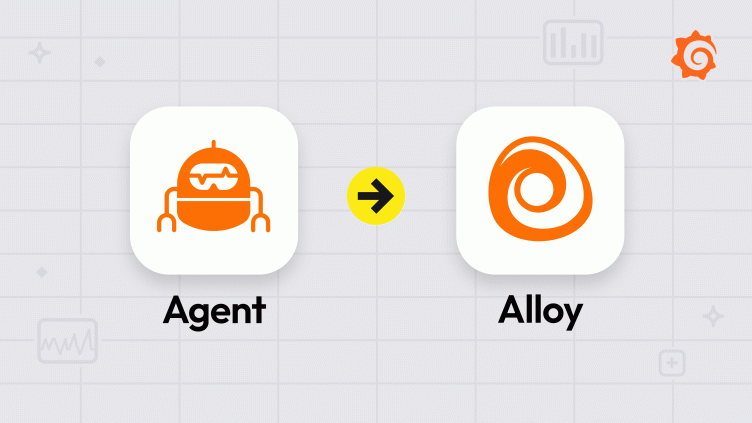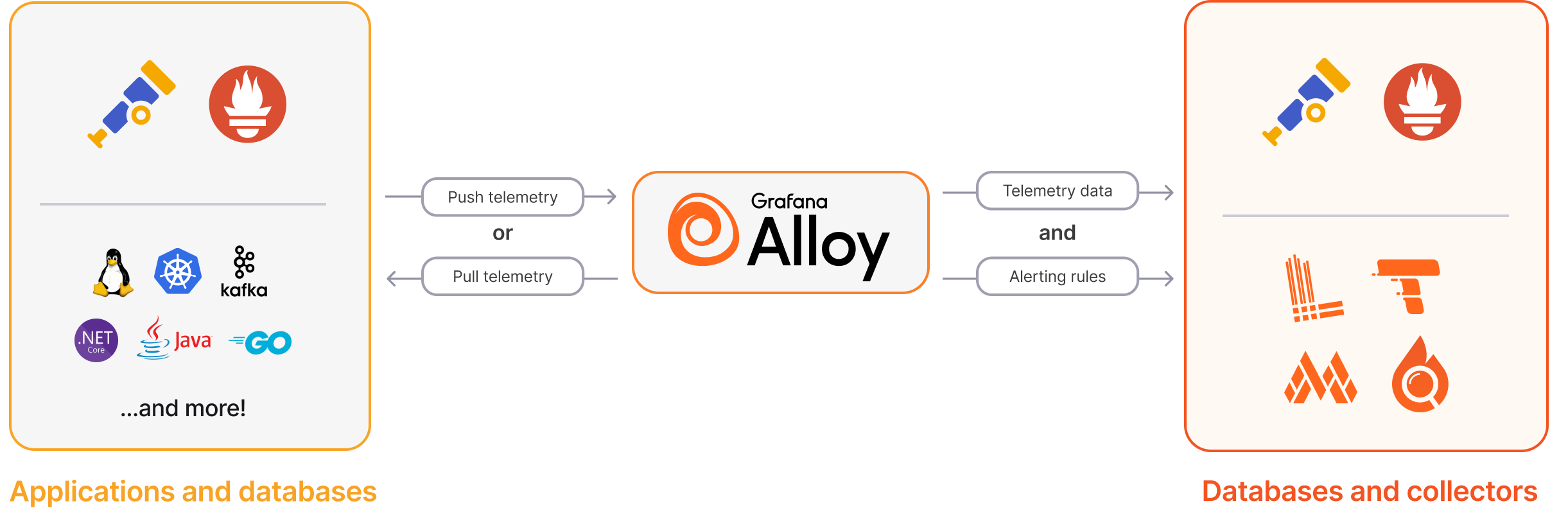
From Agent to Alloy: Why we transitioned to the Alloy collector and why you should, too
When we first rolled out Grafana Agent in 2020, it was a broad OSS solution that addressed common problems that arose as Prometheus became more popular and the use cases became more complex. Grafana Agent was built to be flexible, performant, and compatible with multiple ecosystems, whether the final destination is Grafana Cloud, an on-prem setup of the Grafana LGTM Stack (Loki for logs, Grafana for visualization, Tempo for traces, and Mimir for metrics), or a traditional Prometheus server.
Grafana Agent also proved to be a perfect pairing for Grafana Cloud, which was created to solve issues around centralization and long-term storage for Prometheus data that comes with scale. Grafana Agent became a key part of that solution, acting primarily as a forwarder that only required a small local object storage footprint for backup and recovery.
Over the years, we developed even more agents. We launched Promtail for Loki logs and Grafana Agent Operator for Kubernetes-specific cases. While we love to meet users where they are, providing too many options would often make it harder to determine which agents and methods of deployments to use. And separate binaries means having to manage and install different services if you’ve got a mix of both needs in your overall architecture (e.g., VMs and Kubernetes clusters).
Enter Grafana Alloy, the spiritual successor to Grafana Agent. Alloy is our new open source distribution of the OpenTelemetry Collector that is 100% OTLP compatible and offers native pipelines for OpenTelemetry and Prometheus telemetry formats, supporting metrics, logs, traces, and profiles. It does everything you’d expect of the Grafana Agent project and our other agents — plus so much more. If you are currently using Grafana Agent in your observability stack, we encourage you to migrate to Alloy. Go to our Grafana Alloy announcement blog to learn more.

But we know you must have questions. In this blog post, we try to answer some of them, but we are always open to hearing more. Please find us in the #alloy channel in the Grafana Labs Community Slack or check out Grafana Alloy in GitHub.
1. What happens to Grafana Agent?
Grafana Agent and Grafana Agent Operator are deprecated and will enter into Long-Term Support beginning today (April 9, 2024). This means both Grafana Agent and Grafana Agent Operator will no longer receive any new feature updates, as all future innovation will be put towards Alloy. Grafana Agent and Grafana Agent Operator will only receive critical bug fixes and security fixes, as a result. We recommend that you begin planning your transition towards the new Grafana Alloy collector. Commercial support will continue until the end of the LTS phase, which we anticipate will end in roughly 18 months on October 31, 2025.
End-of-Life (EOL) phase for Grafana Agent and Grafana Agent Operator will begin once LTS ends. Grafana Agent and the Grafana Agent Operator are expected to reach EOL on November 1, 2025. Once EOL is reached, both projects will no longer receive bug fixes or security fixes. It’s recommended that all users stop using Grafana Agent before this date by moving to the new Grafana Alloy collector. Generally, unless specifically outlined on a case-by-case basis, commercial support will end once EOL is reached.
2. What happens to Grafana Agent’s Flow mode?
With the launch of Alloy, Grafana Agent’s Flow mode will also be deprecated. This was an experimental mode for the now-deprecated Grafana Agent that has laid the foundation for Grafana Alloy. It was instrumental towards launching our new collector, and we thank everyone for trying it out early, providing feedback, and helping us shape the launch of Alloy as a result. The transition to Alloy is also an opportunity for us to further simplify the components that make up the new collector. With Grafana Alloy, instead of Flow mode and River concepts, you will simply be interacting with .alloy files, using the Alloy syntax.
For current users of Flow, we encourage you to move your workloads to Alloy, and you can expect the experience to be nearly identical after the transition. You will have to download a new binary and move your configurations to the new collector, but you can then access the latest and greatest features within Grafana Alloy.
3. What’s the best way to get started with Alloy?
Sign up for a free Grafana Cloud account and onboard with one of our easy-to-use integrations or solutions, such as Kubernetes Monitoring or Application Observability. We provide clear, guided instructions for configuring these products to leverage Alloy.
4. How do I migrate to Alloy from Agent and other Grafana tools?
If you are currently using Grafana tools, such as Grafana Agent or Grafana Agent Operator, we have converters and tools for moving to Grafana Alloy, based on your use case.
- Migrate from Operator
- Migrate from Prometheus
- Migrate from Promtail
- Migrate from Grafana Agent Static
- Migrate from Grafana Agent Flow
5. How do I migrate from an existing tool like the vanilla OpenTelemetry Collector?
There’s a converter and guide for that too!
6. Can I still use the OpenTelemetry Collector to send data to Grafana Cloud?
Yes. While Alloy is a branded distribution of the OpenTelemetry Collector that comes with its own set of enhancements, you can still use the OTel Collector to send data to Grafana Cloud.
Got a question about Grafana Alloy?
We welcome hearing more from the community! If you have questions or feedback on Grafana Alloy, please find the team in the #alloy channel in the Grafana Labs Community Slack or check out Grafana Alloy in GitHub.
Grafana Cloud is the easiest way to get started with metrics, logs, traces, dashboards, and more. We have a generous forever-free tier and plans for every use case. Sign up for free now!



